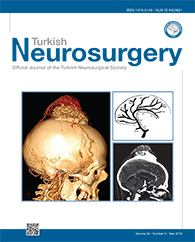2Zhejiang Chinese Medical University, Department of Spinal Surgery, China
*These authors contributed equally to this work and should be considered co-first authors DOI : 10.5137/1019-5149.JTN.12450-14.1 AIM: To assess the feasibility and efficacy of TLIF with unilateral pedicle screw and contralateral percutaneous lumbar transfacet screw fixation for the treatment of lumbar degenerative disorders.
MATERIAL and METHODS: A series of computed tomography (CT) digital images from 60 patients (30 males and 30 females) with L3-S1 segments, were reconstructed in three dimensions using a software named Xelis 3D. Linear and angular measurements of the facets were recorded. Fifty-six patients were divided to either bilateral pedicle screw fixation (BPS) (n=30) or unilateral pedicle screw and contralateral percutaneous transfacet screw fixation (UPFS) (n=26) groups. The operating time, blood loss, length of hospital stay, clinical outcomes, fusion and complication rates were compared between the two groups.
RESULTS: The parameters of the facets we recorded were no significant differences between the left and right sides (p>0.05). No statistically significant differences between males and females were observed, except the maximum width of superior facet at L4 and S1, and length of screw at all levels. Intraoperative parameters, such as operating time, blood loss and postoperative hospital stay had significantly larger in the BPS group than UPFS group (p<0.05). No significant differences were found between the two groups in clinical results, fusion and complication rates (p>0.05).
CONCLUSION: Because of the similar clinical outcomes but less operative time, blood loss and length of postoperatively hospital stay, unilateral pedicle screw and contralateral percutaneous lumbar transfacet screw fixation might be an attractive technique compared to bilateral pedicle screw fixation for treating lumbar degenerative disorders with TLIF. Nevertheless differences of the anatomical parameters for the lumbosacral facets fixation between Chinese and Westerners should be noted.
Keywords : Lumbar facet anatomy, Percutaneous transfacet screw, Lumbar spine fusion, Minimally invasive




